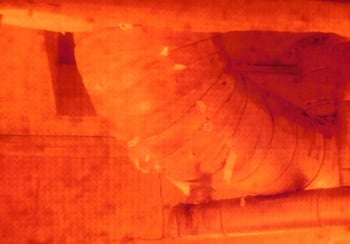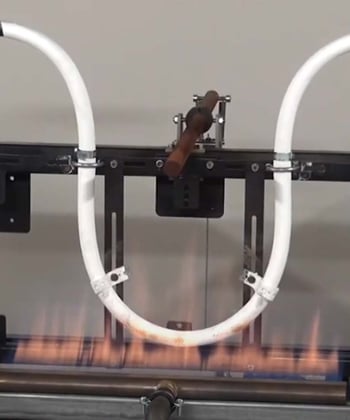A Comparison of Cable Protection Test Standards
You may have heard the phrase “There is more than one way to crack an egg”. It is true that essentially any blunt force applied to the brittle shell, no matter where or how, will result in a cracked egg. What if you want to crack the egg in such a way to be able to use the shell to separate the yolk from the white? What if you want the contents together but want a perfect sunnyside up egg? What if you don’t care because you are scrambling them, and are ok just as long as you don’t end up with shells in your omelet? Of course, the phrase is a witty way of saying there is more than one way to accomplish a task. Some ways are better than others depending on the desired outcome. The same can be said for test standards.
Like in the cracked egg example, there are many standards on the surface that seem to do the same thing, but when you dig into the details the results can be quite different. This is the conundrum we face. How do we know which test method to choose? Coming from the passive fire containment world, we often joke that fires must burn differently in Canada, because there, combustible pipe must be tested with a furnace pressure 20 times higher than in the US. Of course, fires don’t burn differently there. So it boils down to those in our society that define the applicable standards based on what they have been convinced is required to prove the efficacy of a product for the desired outcome. In this particular case, we will look at a few standards that are used to measure the performance of fire-resistive cable systems that are designed to verify the ability of a system to withstand the threat of fire exposure and maintain their ability to perform as intended. This becomes extraordinarily important when cable systems are intended to support life safety systems, such as wired communications systems for emergency responders in a burning building, otherwise known as Auxillary Radio Communication Systems (ARCS), or Emergency Responder Communications Enhancements Systems (ERCES).
The following is a list of the three standards we will review, compare, and contrast:
- ASTM E1725 – Standard Test Methods for Fire Tests of Fire-Resistive Barrier Systems for Electrical System Components
- UL 2196 – Fire Test for Circuit Integrity of Fire-Resistive Power, Control, and Data Cables
- BS 8491 – Method for assessment of fire integrity of large diameter power cables for use as components for smoke and heat control systems and certain other active fire safety systems
For the purposes of this column, we will compare and contrast these standards on the limitations of a system, how the test is performed, conditions of acceptance and resulting ratings, and the practical impact this may have.

Figure 1 – ASTM E1725 Furnace Immersion
Limitations of a System: Some tests are designed to measure the performance of a product that protects a multitude of applications generically. Other tests are designed to measure the performance of a single product in a proprietary way. For example, the ASTM E1725 test measures the temperature rise on the outside surface of a generic conduit or cable tray that is protected as part of a system. As well it measures the temperature rise of a generic single No. 8 bare copper conductor inside the conduit or cable tray. Why test with a single small bare copper conductor when that never happens? The reason copper is chosen is that it represents the most common conductor material that also happens to be one of the best and most efficient materials for transferring heat. By testing it bare, no insulation exists that would resist heat reaching the copper where it would then be efficiently transferred. By testing a single small conductor, it introduces a small mass to the system as opposed to a large mass that may represent a larger cable or more cable fill. Larger mass takes longer to heat up given the same amount of heat energy. As a result, the small cable is a more severe condition and the data from an E1725 test can be applied for more conditions ranging from an empty conduit or cable tray to one that is filled to capacity with cable of varying sizes, types, and insulating jackets. UL 2196 and BS 8491 both test the performance of a proprietary cable system by connecting them to a signal and receiver whereby you can determine exactly when that product ceases to perform it’s intended function when subjected to a standard fire condition. Both scenarios are beneficial, but with the ASTM E1725 testing process you can measure a system performance and choose cables in a generic, often much less expensive way that would operate as intended in a predictable environment. If a cable can withstand an exposure of approximately 400 F and still function, you are unlimited otherwise on the type, size, or quantity. With UL 2196 and BS 8491, the performance is limited to the exact cable tested. In the case of testing to these two standards, the performance may be dialed in better for a specific product but the application of the standard is limited to that product alone. In other words, ASTM E1725 is a test of a system protecting a generic application as opposed to UL 2196 and BS 8491 which applies to a unique product.

Figure 2 – BS 8491 Test
How the Test is Performed: Understanding how a test is performed is key when attempting to address the efficacy of a product or system compared to what would be expected when called into action during a true fire. ASTM E1725 and UL 2196 require a complete submersion into a furnace environment (see Figure 1), rising to 1825 F in 2 hours and exposing the cable or system to an attack of heat energy from every angle for the duration of the test. BS 8491 on the other hand, exposes the cable to a direct flame impingement as the cable is positioned 2 inches above a burner that is located in an open room and is controlled to deliver a constant exposure temperature of 1548°F at the surface of the cable (see Figure 2). While this produces a significant exposure for the bottom side of the cable, the top side is actually shielded from the heat produced by the flame so the cable, at best, is only seeing a direct heat exposure on the bottom and as you climb the sides and extend onto the top, there is a lessening gradient of exposure and virtually no exposure on the top side as all the heat energy is bypassing the cable and rising past it into the open room. It is the same concept as to why the atmospheric temperatures on the moon range from 260°F in the daylight, and dip to -280°F on the dark side. In the same way, the top side of the cable will remain much cooler during the test. By comparison, the ASTM E1725 and UL 2196 test exposures never produce a dark side of the moon moment. When choosing a product or system to maintain life safety connectivity, it is important to consider the exposure it will be subjected to in a true fire and choose a product with a test exposure that corresponds to that environment.
Conditions of Acceptance and Resulting Ratings: When a system or cable has been tested to these standards, the result is a record of performance stated as a measure of time when a transition takes place from meeting the acceptance criteria to no longer meeting the criteria. This can be confusing, because for each standard the performance is displayed in similar fashion – simply a statement of time. For ASTM E1725, that transition takes place when the temperature of the system rises to 325°F above the starting point. When that occurs, the time is marked and that is the stated performance of the system. This is useful information, because any cable can be easily assessed separately for its ability to carry a signal under a heat load environment that mimics the condition produced by the system tested to ASTM E1725. For UL 2196 and BS 8491, the transition takes place when a signal can no longer be carried by that cable under the testing environment. When the transition takes place, the time is marked and is reported. Again, this is useful information but you have to resort to the fact that the performance is specific to a product and cannot be generically applied.
Practical Impact: When a decision needs to be made as to which type of system or cable is most desirable and/or practical, many factors come in to play. You may have very limited space to work with and a single cable is all that is required for transferring a signal. In this case, simplicity of installation may outweigh product cost and/or special tool requirements and installation practices. In which case it may be attractive to use a proprietary cable tested in accordance with UL 2196. On another hand, you may not expect a fire threat to be severe and the relative cost of a system may outweigh the performance expectations. In that case a product tested to BS 8491 may be attractive, although because it is a British standard applicability against the local code requirements would need to be scrutinized. As well, even if the fire threat is not expected to be severe it should be noted that fires are often unpredictable and an underperforming product used for life safety purposes could be catastrophic. Perhaps, there is a desire to be virtually unlimited both in type and quantity of cable and a predictable exposure limit can be used to validate a multitude of options in cabling. Maybe it is important to be able to have the ability to add cable without adding significant cost. In these cases, a system tested to ASTM E1725 is likely a better solution.
The process of choosing protection of life safety communication systems has several avenues as pointed out in these examples. Because of the importance of these applications and their impact on life and death, it is critical to know what a product or system delivers and what limitations exist after the installation. Care needs to be taken to understand how it was tested, what limitations each product or system may have, what the ratings tell you even though they appear identical, and what the practical aspect of the project might be. Once you know the variations in how products that seem to do the same thing are tested, the decision on which product to choose becomes more clear. In conclusion, it should be a matter that is as simple as answering the question “How do you want your eggs?”. It can be that easy if you know what you are looking for.






